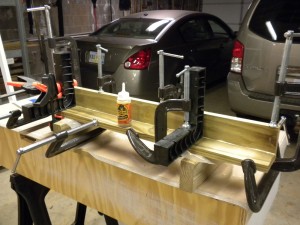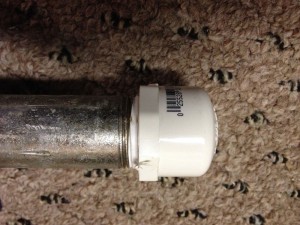Do you, like me, find it annoying when woodworkers find fault with this or that style clamp?
One of my favorite online woodworkers/podcasters recently said, “When I first started woodworking I bought a ton of C-clamps, mostly because they were cheap. Now I wish I had that money back. I never use them anymore.”
I respectfully disagree. I find C-clamps to be exceedingly useful. As you can see from the accompanying photo, I have a ton of them, in all sizes.

From 4″ to 12″ my C-clamps see a lot of action. A 12″ C-clamp can apply so much pressure, it will open a coconut. Spread that pressure out with a caul and you have a clamp with a lot of reach combined with a lot of power.
Like most tools, there are situations where they are perfect, and situations where they are useless.

C-clamps can apply an amazing amount of pressure for minimal cost. Use a caul to prevent marring your work. There isn’t a clamp in my shop that could have done this job as well.
It is also not unusual to hear woodworkers putting down pipe clamps, but, they have their place and like my imported C-clamps, you can’t beat the price. Some brands of pipe clamp heads, also called “jaws,” come with a nifty spiral spring-wire to protect the threads on the distal end, the end opposite the head. While it’s not necessary to even have threads on that end, it is useful when joining two lengths of pipe together to make a really long clamp.
If the style of jaws you have doesn’t include that spring, you can inexpensively protect the threads with a threaded 3/4″ PVC cap.

It’s not terribly difficult to cross-thread the soft PVC on steel pipe. To make the cap easier to install and remove at a later date, wrap a layer or two of Teflon thread tape on first.
Jim Randolph is a veterinarian in Long Beach, Mississippi. His earlier careers as lawn mower, dairy farmer, automobile mechanic, microwave communications electronics instructor and journeyman carpenter all influence his approach to woodworking. His favorite projects are furniture built for his wife, Brenda, and for their children and grandchildren. His and Brenda’s home, nicknamed Sticks-In-The-Mud, is built on pilings (sticks) near the wetlands (mud) on a bayou off Jourdan River. His shop is in the lower level of their home. Questions and comments on woodworking may be written below in the comments section. Questions about pet care should be directed to his blog on pet care, www.MyPetsDoctor.com. We regret that, because of high volume, not all inquiries can be answered personally.

